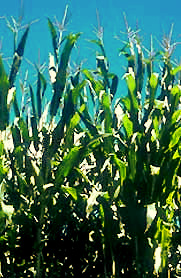 Something to keep in mind about the corn plant, or maize, is that it's a grass. It's a member of the Grass Family, just like crabgrass, wheat, rice, oats, bamboo and sugarcane. To understand corn flowers you should know the basics about average grass flowers, as explained on our Grass Flower page.
Something to keep in mind about the corn plant, or maize, is that it's a grass. It's a member of the Grass Family, just like crabgrass, wheat, rice, oats, bamboo and sugarcane. To understand corn flowers you should know the basics about average grass flowers, as explained on our Grass Flower page.
Corn's scientific name is Zea mays. Mankind has changed the corn plant very much from its primitive, wild ancestors. It was first domesticated by indigenous peoples in southern Mexico about 10,000 years ago. Wikipedia provides an interesting review of Corn's Pre-Columbian development.
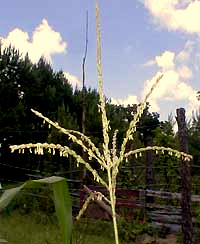
Using terminology appropriate for grasses, we can say that atop each mature corn plant many spikelets of male florets (commonly thought of as male flowers) gather into a conspicuous, spreading inflorescence known as a tassel, as shown at the left. The items dangling from the tassel's branches are pollen-producing anthers attached to threadlike filaments.

Each tassel branch bears many individual male spikelets, two of which appear at the right. The greenish glumes of each spikelet hide within them two male florets, with each floret produceing three stamens. The pale items looking like tiny dangling bananas are three anthers produced by a mature male floret covered by a spikelet's pair of glumes.
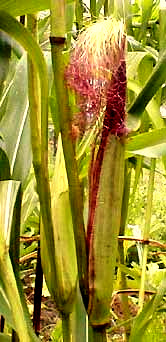
A tiny fraction of the clouds of pollen normally produced in a field of corn falls onto the soft, wavy, often-purplish, hairlike silks of immature corn ears, as shown at the left. Typically a corn plant's male and female florets mature at different times, so self-pollination doesn't occur. Ears of corn exhibit amazing modifications of what's normal for a grass's female sexual parts.

First of all, the silks are exceptionally long styles of the ovaries in the corn plant's female florets. The single ovary in each female floret produces two style branches, which is normal for grasses, but, in corn, the style branches are fused, except at the very tip. They look like just one style. The styles' tips, hanging outside the immature ear of corn, are stigmatic, meaning that they're sexually receptive to germinating corn pollen. At the right you see the tip of a corn's silk, its double nature apparent, and its tip with stigmatic hairlike projections.
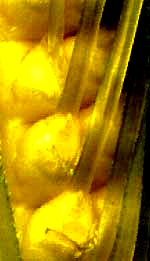
So, a pollen grain germinates on the silk's stigmatic tip, producing a rootlike thing with the male sex germ at its tip. The rootlike thing grows down through the entire length of the silk, where at its bottom it enters a caryopsis-type ovary, as shown at the left. A caryopsis is a dry, one-seeded fruit which doesn't split open a maturity, and in which the ovary wall is united with the seed coat, so that the fruit is indistinguishable from the seed. The Grass Family's "cereal grains," like wheat, oats, barley and rice, produce caryopses, though most grass fruits are of the cypsela type.
The caryopsis of the Corn plant's female floret, then, is what will develop later into a grain of corn.
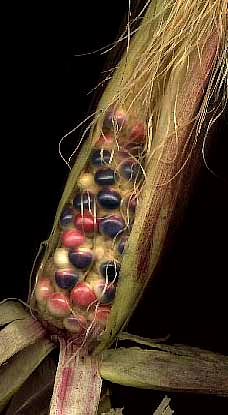
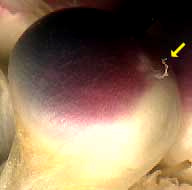
At left, a single grain of traditional "Indian Corn" shows the shriveled remnants of its style, at the tip of the yellow arrow. At the right, a mature ear of Indian Corn shows one silk connecting to each grain in ear. In that picture you also see several large, papery items enveloping the corn grains on their "cob." In regular English the papery things are called "husks," and when they're removed for eating the corn, one "shucks" the corn. Some people call the husks shucks. Whatever you call them, they're the corn stalk's modified leaf sheaths plus one modified leaf, the sheath often ending in an apparent but reduced blade.
A final curiosity about corn sexuality is that the female florets occur in pairs of rows running up the rachis that will mature into a corncob. This means that an ear of corn always has an even number of rows of grain running up the cobs. Some "hucksters" have been known to win a bet that a randomly chosen ear of corn has an even number of rows of grain...